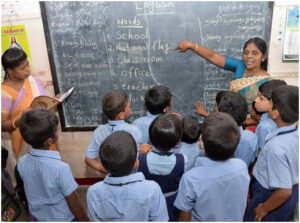Remedial teaching is identifying slow learners and providing them with the necessary help and guidance to help them overcome their problems, after identifying their areas of difficulty. A remedial teaching class is one that is meant to improve a learning skill or rectify a particular problem area in a student.
In simple terms, a remedial program is for students who have average or higher intellectual abilities but who are not performing well in school. Typically, remedial students are not struggling because of their intellectual abilities but instead because they are struggling with one subject area like reading, writing or mathematics. Remedial programs are designed to help give the students the individual attention that they need to build their skills and their confidence so that they can live up to their potential. Differentiated Instructions which incorporates effective use of resources to target learners of different abilities is a wonderful technique that can lower the need of remediation to an extent.
Special education differs from remedial education because the students in these programs lack the intellectual ability to perform in a class that teaches standardized concepts and subjects. The students in these classes may lack social maturity, emotional maturity, physical ability or the analytical skills that are needed to perform in a remedial or a standard classroom environment.
Remedial programs that offer students special one-on-one attention are much more in demand. Many students today find it difficult to sit down and stay focused in class because the delivery of traditional lectures does not grasp the attention of all learning types.By relating the individual learning differences to students’ developmental situations, teachers can develop appropriate activities that meet the needs of their students in the classroom, small groups, or individual lessons.” In other words, the use of art, movement exercises, or other creative tutoring can enhance more common methods such as repetition and comprehension activities.
We cannot make students learn. But we can create circumstances in which learning is more likely—a responsibility expert teachers accept. Teachers can help students learn by taking the time to observe and find out about what students are interested in and then encourage students to connect their interests to the topic under study. Teachers further stimulate student learning by examining what each student says or writes and correcting misperceptions that are revealed. Consistently responding in a supportive manner increases the likelihood that students will learn.
Learning is usually invisible. We cannot see what is in the mind of another, although sometimes we hear it: “Now I get it”, Oh! Its that way! . Teachers must constantly strive to evaluate the learning based on learning outcomes to ensure that appropriate learning is on track. This is usually a tedious process which requires complete attention of both learner and teacher. Teachers need to be cautious about the methods they employ to test these learning outcomes as all skills learnt cannot be judged throughonly the written tests.
In rural India, nearly three-quarters of students in grade 3 cannot not solve a two-digit subtraction such as “46 – 17”—and by grade 5, half still could not do so. The Urban Education Scene ( inpublic sector education ) in terms of Learning gaps is also similar.
“The only way to make progress is to ‘find truth from facts.’ If we let them, the facts about education reveal a painful truth. For too many children, schooling does not mean learning,” said World Bank Chief Economist, Paul Romer.
Relying on evidence and advice gathered during extensive consultations in 20 countries, with governments, development and research organizations, CSOs, and the private sector, the world economic report offers three policy recommendations:
First, assess learning, so it can become a measurable goal.
Only half of all developing countries have metrics to measure learning at the end of primary and lower secondary school. Well-designed student assessments can help teachers guide students, improve system management, and focus society’s attention on learning. These measures can inform national policy choices, track progress, and shine a spotlight on children who are being left behind.
Second, make schools work for all children.
Level the playing field by reducing stunting and promoting brain development through early nutrition and stimulation so children start school ready to learn. Attract great people into teaching and keep them motivated by tailoring teacher training that is reinforced by mentors. Deploy technologies that help teachers teach to the level of the student, and strengthen school management, including principals.
Third, mobilize everyone who has a stake in learning
Use information and metrics to mobilize citizens, increase accountability, and create political will for education reform. Involve stakeholders, including the business community, in all stages of education reform, from design to implementation.
“Developing countries are far from where they should be on learning. Many do not invest enough financial resources and most need to invest more efficiently. But it is not only a matter of money; countries need to also invest in the capacity of the people and institutions tasked with educating our children,” said Jaime Saavedra, a former Peruvian Education Minister, and now the World Bank’s Senior Director for Education. “Education reform is urgently needed and requires persistence as well as the political alignment of government, media, entrepreneurs, teachers, parents, and students. They all have to value and demand better learning.”


Best Practices for Remediation
Remediation should not be seen as punishment, in fact it should be made popular through regular parent counselling.
Students individual learning strengths must be evaluated and the data must be used to determine which students need to improve on which skills or standards.Chunk Skills of learning into smaller tasks that can be done over time rather than giving one project.
Using Peer Tutors to explain concepts in different words is also recommended to help students overcome the challenges of grasping the concepts .Letting students track their progress and results helps to keep them involved in their own learning
Use small group instructions or learning stations to let students work in teams based on similar needs.Spiral Learning is also recommended to reinforce the concepts taught.
Self Grading exercises online or Apps are also recommended to ensure the feedback is instant and the learning can be tracked and Artificial Intelligence in such apps helps leverage tasks based on improvement in learning learning .Flipped remediation ( sharing resources pre classes like videos , text files etc ) may also be helpful if learners have access to technology.
,
Have students reflect on their strengths and weaknesses as well as the results of their class and home activities .

Recent Comments